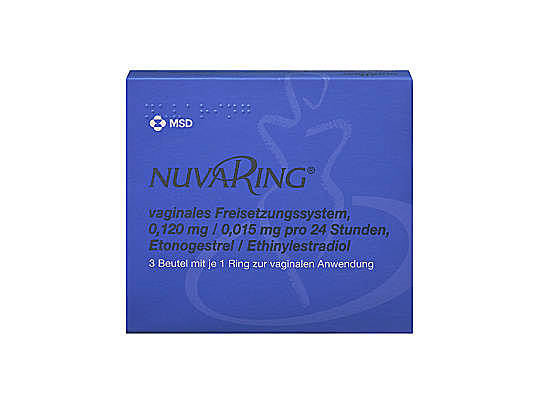NuvaRing
Contraceptive Vaginal Ring With Etonogestrel and Ethinylestradiol


NuvaRing is a vaginal delivery contraception for women of reproductive age range 18-40 years. To place a prescription order for this vaginal ring, fill in our short online questionnaire. You can choose a preferred treatment, such as NuvaRing, Cerazette, or Microlite.
One of our doctors will check if the contraception is suitable for you and issue your prescription to a local pharmacy in Ireland or your home address. You can also choose to have your medication delivered directly to your door. A consultation for contraception prescription costs €21.50.



About NuvaRing
-
-
NuvaRing is a small, combined hormonal contraceptive vaginal ring that you put into your vagina to prevent pregnancy. It is a flexible plastic ring that lasts for 3 weeks at a time, and is just as effective as the contraceptive pill when used correctly.
NuvaRing is a small plastic ring, just 54 mm in diameter and 4mm wide, which releases a low, controlled dose of the sex hormones etonogestrel and ethinylestradiol into your body every 24 hours. These hormones prevent pregnancy by stopping the ovaries from releasing an egg, preventing fertilisation from taking place.
NuvaRing works just like the combined contraceptive pill, but instead of having to remember to take a pill every day, you insert the ring and keep it in for 3 weeks in a row. That means it can be a convenient alternative to combined hormonal contraceptive pills for women who find it difficult to remember to take the pill every day.
-
-
NuvaRing comes in boxes of 3. You insert 1 ring into your vagina and leave it there for 3 weeks, then remove it for 1 week so that you can have your period. The ring releases 2 sex hormones into the body at a low dose to prevent pregnancy. After a week’s break, you insert a fresh ring from the pack and repeat the process.
-
-
NuvaRing can be easily inserted in a similar way to a tampon, and you usually won’t feel it once it’s in place.
You can insert NuvaRing by taking the following steps:
- Wash and dry your hands.
- Find a position that is comfortable for you, for example standing with one leg up on a chair or the bath, squatting, or lying down (if you use tampons, you’ll be used to this).
- Open the foil pouch containing the ring (it’s a good idea to keep the pouch so that you can dispose of it after use).
- Hold the NuvaRing between your thumb and index finger and press the sides of the ring together to fold it.
- Using your index finger, gently insert it into your vagina and push it up inside you.
It may move around a little bit in your vagina, which is normal. You may not feel it at all or may be aware of the ring inside you. It shouldn’t feel painful or uncomfortable – if it does, you may not have pushed it far enough inside your vagina. Gently push it in as far as you can. Don’t worry, you can’t push it too far or lose it inside you.
When you have been using the NuvaRing for 3 weeks, it can be removed by inserting your index finger inside you and hooking it through the ring. Gently pull in a down and forward motion to pull the ring out and throw it away in the bin, not the toilet.
To continue using NuvaRing, insert a new one 7 days later, on the same day of the week and at the same time as you removed the last one. Insert a new ring even if your period hasn’t finished yet.
-
-
NuvaRing has been proven to be 98% effective in preventing pregnancy when used properly. To be most effective, it must be inserted correctly, so it stays in place for 3 weeks. It can sometimes get dislodged by intercourse or other activities such as straining when you go to the toilet for a bowel movement, so you should regularly check that it is still in place.
If your NuvaRing does come out for any reason, put a new one in as soon as possible. You may need to use additional contraception for a while to ensure that you are still protected from getting pregnant. If in doubt, speak to your doctor or pharmacist.
-
-
As with all medicines, NuvaRing can cause side effects, although not everybody gets them. Speak to your doctor if you experience any side effects when using NuvaRing.
Common side effects of using the vaginal ring are:
- feeling sick (nausea)
- abdominal pain
- a vaginal yeast infection such as thrush
- discomfort in the vagina from the ring
- genital itching
- vaginal discharge (secretion)
- breast tenderness
- painful periods
- weight gain
- headaches
- lowered libido (sex drive)
- depressed mood
- acne
- the ring may fall out
If you experience any of these side effects, or any side effects not mentioned here, speak to your doctor or pharmacist.
-
-
As with using any combined hormonal contraception, NuvaRing increases a woman’s risk of developing blood clots compared with a woman not taking any combined hormonal contraception. Blood clots in veins or arteries can potentially be very serious. Therefore, NuvaRing may not be a suitable form of contraception for women who are already at risk of developing blood clots due to other conditions.
The risk of developing blood clots when using a combined hormonal contraceptive such as NuvaRing is increased if:
- you are over 40
- you are overweight
- a close family member has ever had a blood clot in their lungs, other organs or legs
- you will be immobile for a period, for example after an operation
- you have broken your leg, and it is in a cast
- you are a smoker
- you have high blood pressure
- a close family member has suffered a heart attack or stroke at a young age
- you have high cholesterol or triglycerides (fat) in your blood
- you get migraines with aura
- you are diabetic
- you have any heart condition (for example, irregular heartbeats)
Speak to your doctor before using NuvaRing if any of the above apply to you.
-
-
NuvaRing contains the active substances 11.7 mg etonogestrel and 2.7 mg ethinylestradiol. The active substances are released from the ring at a rate of 0.120 mg/day and 0.015 mg/day each day, for three weeks. Copolymer is a type of plastic that will not dissolve in the body. NuvaRing also contains the inactive ingredient magnesium stearate.

Babak studied medicine at King’s College London and graduated in 2003, having also gained a bachelor’s degree in Physiology during his time there. He completed his general practice (GP) training in East London, where he worked for a number of years as a partner at a large inner-city GP practice. He completed the Royal College of GPs membership exam in 2007.
Meet our doctorsLast reviewed: 06 Jun 2023
